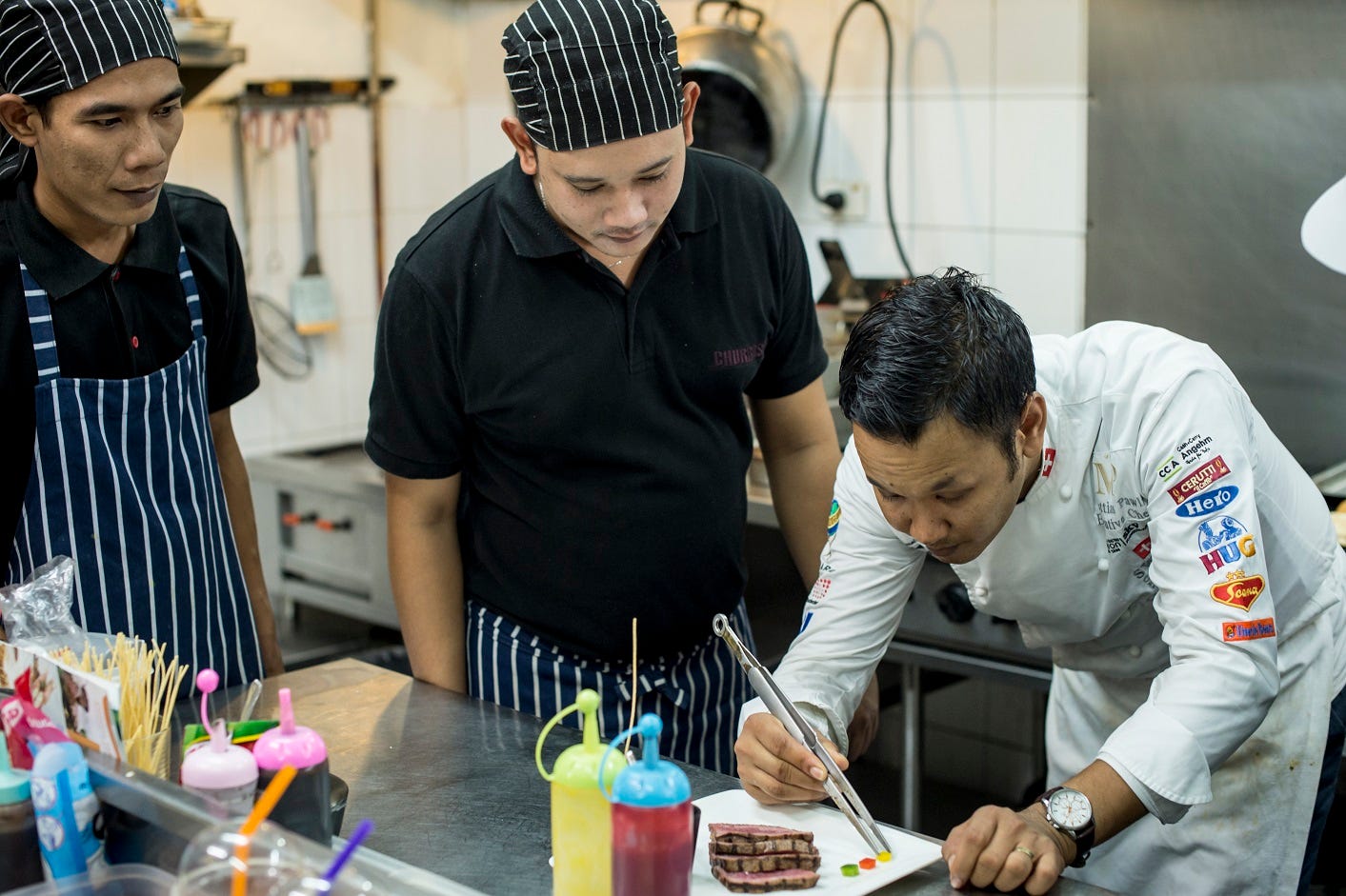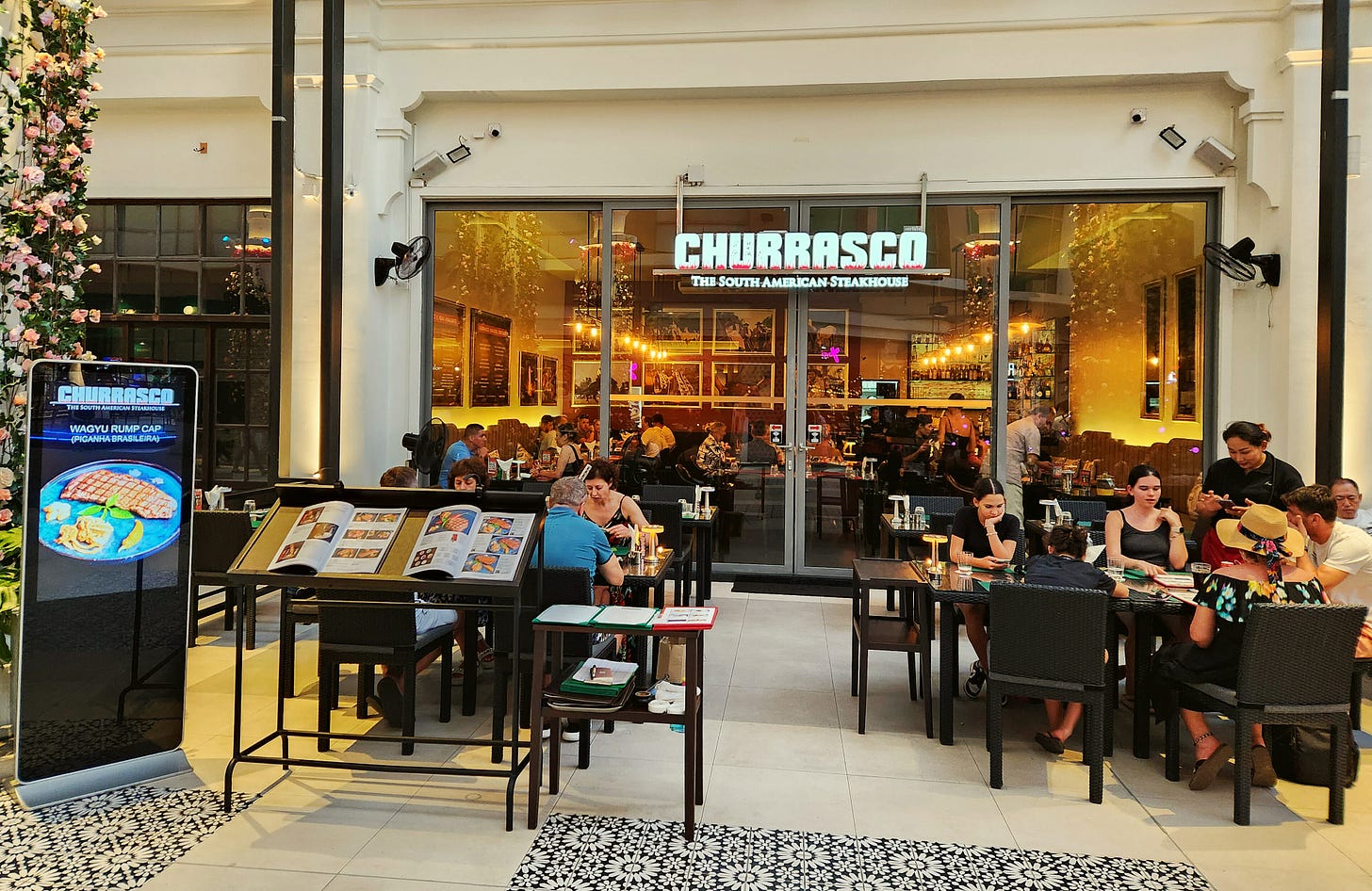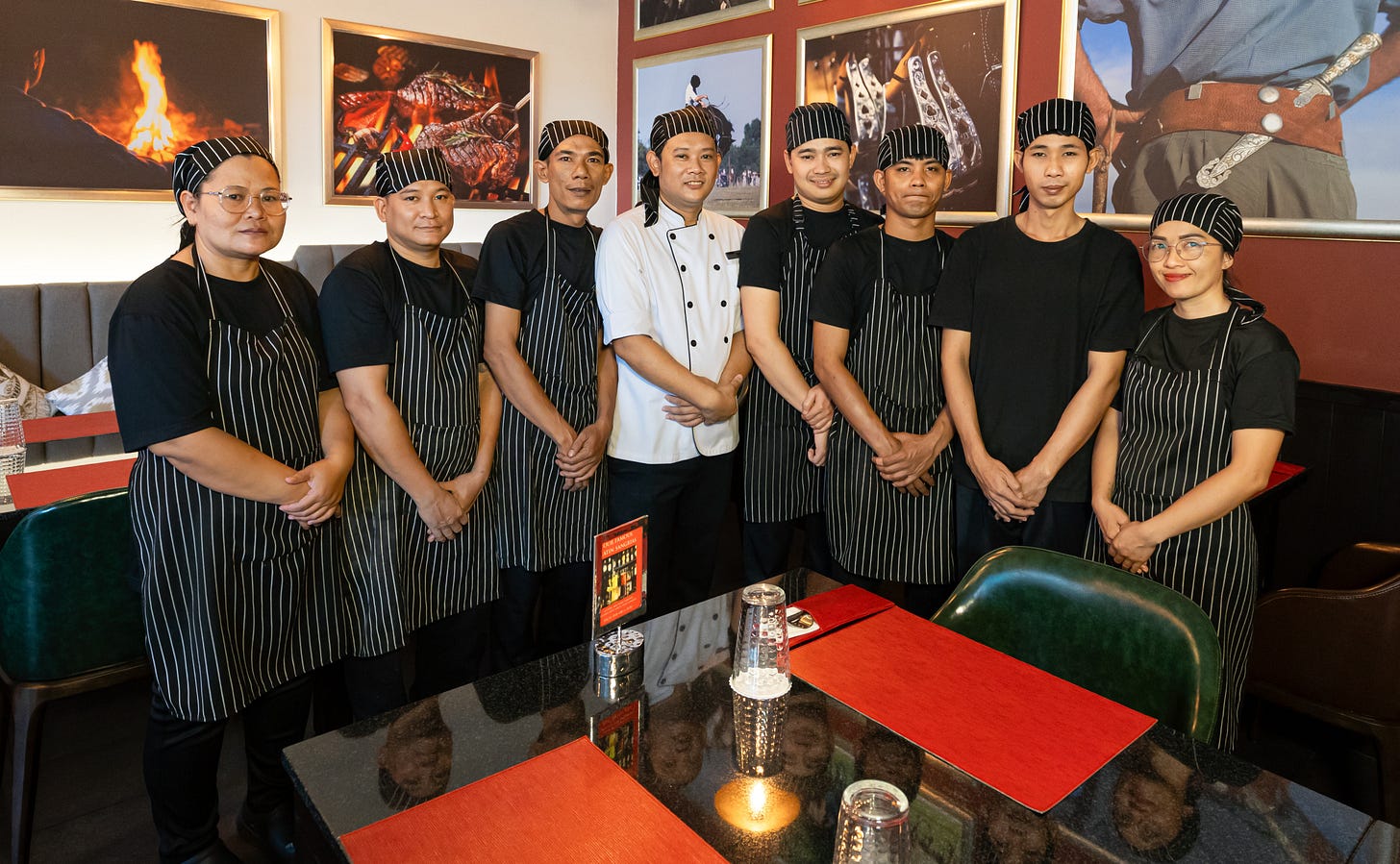
by Ross Kingsley | Jun 1, 2025 | RESTAURANT BUSINESS: BEHIND THE KITCHEN DOOR
First impressions are everything, not only in the world of hospitality. Remember that while outstanding food and a well-designed spaces are important, how guests are welcomed can be a difference between a one-time visit and a loyal customer. The greeting a guest receives upon entering (and leaving) your restaurant sets the tone for their entire experience.
Guest Welcomes Are Crucial
A guest’s dining journey begins the moment they walk through the door, not when they taste the first bite of food. Studies show that strong customer service influences not only repeat business but also positive word-of-mouth marketing. According to hospitality research, 68% of customers say they are willing to spend more at establishments known for good service, while poor initial interactions have caused 78% of customers to back out of purchases altogether. Welcoming a guest warmly communicates that they are valued. It instantly forms a connection that can make the difference between a guest feeling like just another number or feeling like a cherished visitor.
Effective Greeting Techniques
When greeting guests, authenticity matters. Avoid overly scripted phrases that can sound mechanical. A simple “Good evening, welcome to [Restaurant Name]” with a genuine smile goes much further than a rehearsed line. Other natural greetings include:
-
“Thanks for joining us tonight, I’m [Name].”
-
“Good to see you, hope you’re having a great day!”
Making eye contact, standing tall with relaxed posture, and offering a warm tone of voice are all small but powerful signals that say, “We’re glad you’re here.”
Personal Touches
After the initial greeting, a little small talk can build rapport. Simple questions about the day, the weather, or special plans help humanize the interaction. For example:
For returning guests, recognizing them and referencing previous visits elevates the experience: “Welcome back! Will it be the usual table today?” Personal recognition makes guests feel seen and appreciated, enhancing loyalty.
Compliments and Directional Greetings
Sincere compliments can also set a positive tone—mentioning a guest’s outfit, a cheerful attitude, or anything genuine you notice. Directional greetings, meanwhile, help guests feel looked after right away. For example:
Immediate, confident guidance helps guests settle in quickly, creating a seamless entry into the dining experience.
The Key Ingredients Beyond Words
Welcoming guests effectively goes beyond words alone. Appearance, timing, and body language are equally critical:
-
Dress Code: Staff should always maintain a clean, professional appearance. First impressions are visual as much as verbal.
-
Promptness: Guests should be greeted within moments of entering. Delays create unease and the sense of being overlooked.
-
Body Language: Positive body language—eye contact, open posture, and friendly gestures—speaks volumes. Avoid crossed arms, lack of acknowledgment, or distracted behavior.
Training teams to be aware of these nonverbal cues ensures a more consistent and pleasant welcoming experience.
Don’t Forget the Goodbye
While much emphasis is placed on the first greeting, the way guests are bid farewell is just as important. A warm, genuine goodbye leaves a lasting final impression. Simple phrases like “Thank you for coming,” “We hope to see you again soon,” or “Safe travels!” help close the experience on a positive note. In Japanese restaurants, this practice is treated with utmost importance. Staff often line up to bow and thank guests loudly and warmly as they leave, signaling deep respect and appreciation. It’s not just tradition—it reinforces the guest’s value and encourages repeat visits. A thoughtful goodbye is a small gesture that costs nothing but pays dividends in guest loyalty.
The Big Picture
A welcoming atmosphere does not stop at the door. It extends through every interaction, from table service to payment. Establishing a culture where every guest is treated with genuine hospitality is essential. It’s not just about formal etiquette but about fostering a natural spirit of warmth, attentiveness, and care.
In an industry where competition is fierce and online reviews carry significant weight, creating exceptional first and last impressions isn’t optional. It’s one of the most effective, least expensive investments a restaurant can make.
Good service starts with a good welcome—and ends with a heartfelt farewell.
Image Credit: https://freepik.com
_ _ _
© CHURRASCO PHUKET STEAKHOUSE / ALL RIGHTS RESERVED
Reprinting, reposting & sharing allowed, in exchange for a backlink and credits
Churrasco Phuket Steakhouse serves affordable Wagyu and Black Angus steaks and burgers. We are open daily from 12noon to 11pm at Jungceylon Shopping Center in Patong / Phuket.
We are family-friendly and offer free parking and Wi-Fi for guests. See our menus, reserve your table, find our location, and check all guest reviews here:
https://ChurrascoPhuket.com/
#Churrascophuket #jungceylon #phuketsteakhouse #affordablewagyu #wagyu
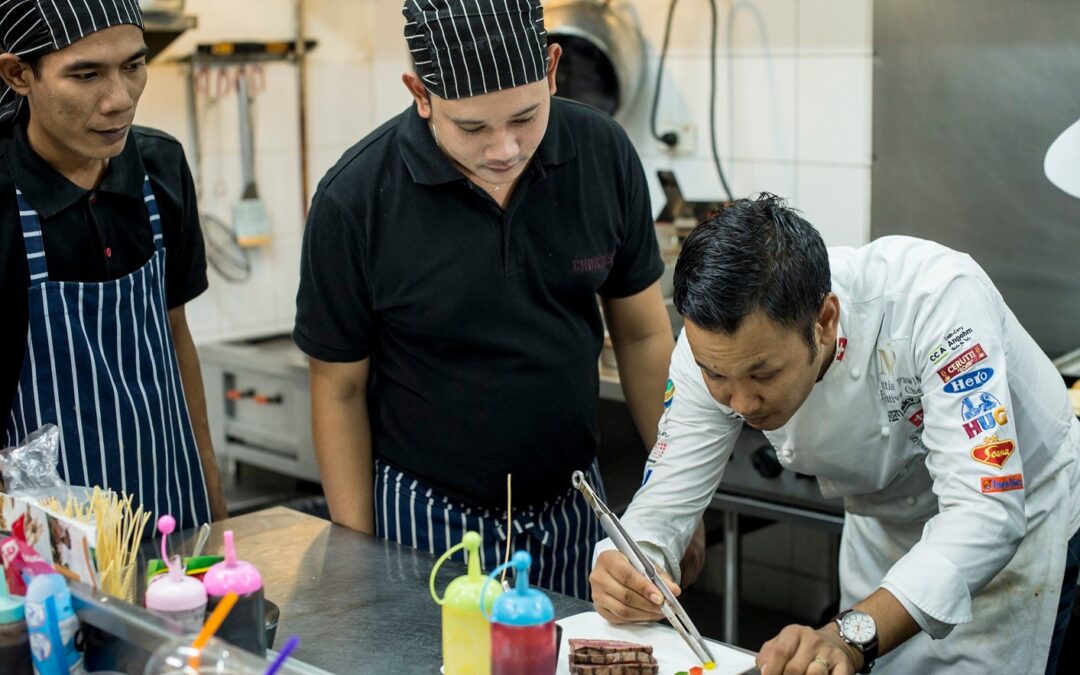
by Ross Kingsley | May 11, 2025 | RESTAURANT BUSINESS: BEHIND THE KITCHEN DOOR
Passion isn’t a strategy. Starting a restaurant is one of the boldest moves an entrepreneur can make. The food industry is fast-paced, competitive, and notoriously unforgiving. It’s tempting to think that passion and taste are enough to drive success, but here’s a cold truth: what you like doesn’t matter. What your target market wants means everything.
“Wouldn’t It Be Nice” Is Not a Business Plan
One of the most common pitfalls aspiring restaurateurs fall into is designing their concept based on personal cravings or nostalgia. If your business plan begins with a sentence like, “Wouldn’t it be great if there were a [your favorite cuisine] place here,” then you’ve already missed the mark. A restaurant isn’t a personal art project—it’s a customer-facing enterprise. Your concept has to be commercially viable. That means serving something people not only want, but will return for—and tell others about. Your own enthusiasm might fuel the early days, but it won’t pay the bills.
It’s Not About You—It’s About Them
The hard truth? Your restaurant is not for you. It doesn’t matter if you adore Hungarian dumplings, or think 1970s disco décor is due for a revival. Unless your potential guests feel the same, your preferences are irrelevant. With few exceptions (your mother included), nobody is coming to support your taste—they’re coming to satisfy theirs. Building a restaurant means building an experience for your customer. Every detail, from menu to music, has to cater to what excites them—not you.
What Makes a Concept Work
A winning restaurant concept has three critical ingredients: demand, differentiation, and repeat appeal.
-
Demand: Does the market want it? Look for unmet needs or underserved niches in your area.
-
Differentiation: How are you standing out? If your concept doesn’t have a clear edge or unique value proposition, you’ll blend into the noise.
-
Repeat Appeal: Can people enjoy it over and over again? The restaurant has to become part of your guests’ routine or social life.
You’re not looking for a hundred people to visit once—you need 50 or more people to come every day. That’s the difference between a restaurant business and a cooking hobby.
Know Your Audience—Then Test It
Before you pour time and money into a full build-out, take a moment to get real about your market. Study the demographics. What restaurants are already thriving nearby? What’s missing? Are people dining out for speed, comfort, trendiness, value, or something else entirely? Next, validate your idea. Host a pop-up. Cater a few private events. Offer delivery from a ghost kitchen. See how people respond—not just with words, but with wallets. If you can’t win hearts and stomachs on a small scale, you won’t magically do it in a 60-seat dining room.
Build a Destination, Not a Vanity Project
The goal is simple: create a place your customers can’t stay away from. That means providing something consistently excellent, shareable, and relevant. Your restaurant has to be woven into the local lifestyle. It needs to be the answer to “Where should we eat tonight?”—not just a pretty idea you love.
Conclusion: The Concept Is the Foundation
In the restaurant world, your concept is the cornerstone of everything. If it’s weak, even the best food and service won’t save you. Get it right, and you’ll have a scalable, profitable business. Get it wrong, and you’re left with an expensive, exhausting hobby. Start not with your cravings, but with your customers’. That’s the difference between a restaurant that thrives—and one that closes quietly before the lease runs out.
Image Credit: https://churrascophuket.com
_ _ _
© CHURRASCO PHUKET STEAKHOUSE / ALL RIGHTS RESERVED
Churrasco Phuket Steakhouse serves affordable Wagyu and Black Angus steaks and burgers. We are open daily from 12noon to 11pm at Jungceylon Shopping Center in Patong / Phuket.
We are family-friendly and offer free parking and Wi-Fi for guests. See our menus, reserve your table, find our location, and check all reviews here:
https://ChurrascoPhuket.com/
#Churrascophuket #jungceylon #phuketsteakhouse #affordablewagyu #wagyu

by Ross Kingsley | May 4, 2025 | RESTAURANT BUSINESS: BEHIND THE KITCHEN DOOR
TripAdvisor was once the go-to platform for travellers seeking reviews and recommendations. With its extensive database of hotels, restaurants, and attractions, it shaped travel decisions for millions. However, in recent years, TripAdvisor’s relevance has diminished as platforms like Google Maps and Dianping have taken the lead.
Google Maps: Convenience Redefined
Google Maps has transformed from a navigation tool into a comprehensive local discovery platform. Unlike TripAdvisor, which requires users to visit a separate app or website, Google Maps seamlessly integrates reviews, photos, and ratings directly into its interface. This convenience allows users to find the best spots in real-time without switching platforms. Its personalized recommendations, based on user location and preferences, further enhance its appeal. Moreover, the global dominance of Google means its data is often more up-to-date and comprehensive, covering not just major tourist spots but also hidden local gems.
Dianping: A Regional Powerhouse
In markets like China and parts of Southeast Asia, Dianping has emerged as a dominant force. Often referred to as “China’s Yelp,” Dianping offers detailed reviews, discounts, and even reservation services. Its deep integration with Chinese payment platforms like Alipay and WeChat Pay makes it particularly convenient for users. Furthermore, Dianping’s focus on local insights and crowd-sourced reviews provides a depth of information that TripAdvisor often lacks in these regions.
Why TripAdvisor is Falling Behind
TripAdvisor’s static model and reliance on user-generated reviews have become less competitive. It lacks the real-time, personalized features of Google Maps and the localized expertise of Dianping. Additionally, its interface can feel dated, and its emphasis on international tourism overlooks the growing demand for localized, everyday experiences.
As travel evolves, platforms that prioritize convenience, integration, and personalization—like Google Maps and Dianping—are taking the spotlight, leaving TripAdvisor behind, and much to restaurant owners’ delight ….
Image Credit: https://freepik.com
_ _ _
© Churrasco PHUKET STEAKHOUSE / ALL RIGHTS RESERVED
Churrasco Phuket Steakhouse serves affordable Wagyu and Black Angus steaks and burgers. We are open daily from 12noon to 11pm at Jungceylon Shopping Center in Patong / Phuket.
We are family-friendly and offer free parking and WiFi for guests. See our menus, reserve your table, find our location, and check all reviews here:
https://Churrascophuket.com/
#Churrascophuket #jungceylon #phuketsteakhouse #affordablewagyu #wagyu

by Ross Kingsley | Apr 27, 2025 | RESTAURANT BUSINESS: BEHIND THE KITCHEN DOOR
When launching a restaurant, your team isn’t just a group of employees—it’s both the backbone ad the guest interface of your establishment. From the chefs crafting impeccable dishes to the servers creating memorable guest experiences, a motivated and loyal team is essential for long-term success. But how do you foster loyalty, motivation, and high performance among your staff?
Here are three key strategies:
1. Create a Strong Culture of Communication
Effective communication sets the tone for a supportive work environment. Hold regular team meetings to discuss goals, address concerns, celebrate achievements and chart a career path forward for the top performers. Encourage open dialogue where staff feel comfortable sharing ideas or feedback. When team members know their voices are valued, they’re more likely to stay engaged and committed.
2. Invest in Personal and Professional Development
Empower your staff to solve problems on the spot, and help them grow within their roles. Offer training sessions, mentorship, and opportunities to take on new responsibilities. For example, a Line Cook aspiring to become a Sous Chef will appreciate a pathway for growth. This investment not only improves performance but also strengthens loyalty as employees see their future tied to the restaurant’s success.
3. Organize Team Events to Build Morale
Workplace camaraderie is a powerful motivator. Organize regular team-building activities, whether it’s a casual outing, BBQ party, or relevant games and friendly competitions. Events like off-site adventures give your staff a chance to bond outside the workplace, which is especially useful to improve the often tense relationship between the kitchen and service teams. These shared experiences foster trust and create a sense of belonging.
Starting a restaurant is challenging, but a motivated team can turn obstacles into opportunities. By prioritizing communication, development, and team-building events, you’ll create an environment where employees are motivated to perform their best—not just for a paycheck, but because they truly believe in the mission and each other
Image Credit: https://churrascophuket.com/about/
_ _ _
© CHURRASCO PHUKET STEAKHOUSE / ALL RIGHTS RESERVED
Churrasco Phuket Steakhouse serves affordable Wagyu and Black Angus steaks and burgers. We are open daily from 12noon to 11pm at Jungceylon Shopping Center in Patong / Phuket.
We are family-friendly and offer free parking and Wi-Fi for guests. See our menus, reserve your table, find our location, and check all reviews here:
https://ChurrascoPhuket.com/
#Churrascophuket #jungceylon #phuketsteakhouse #affordablewagyu #wagyu
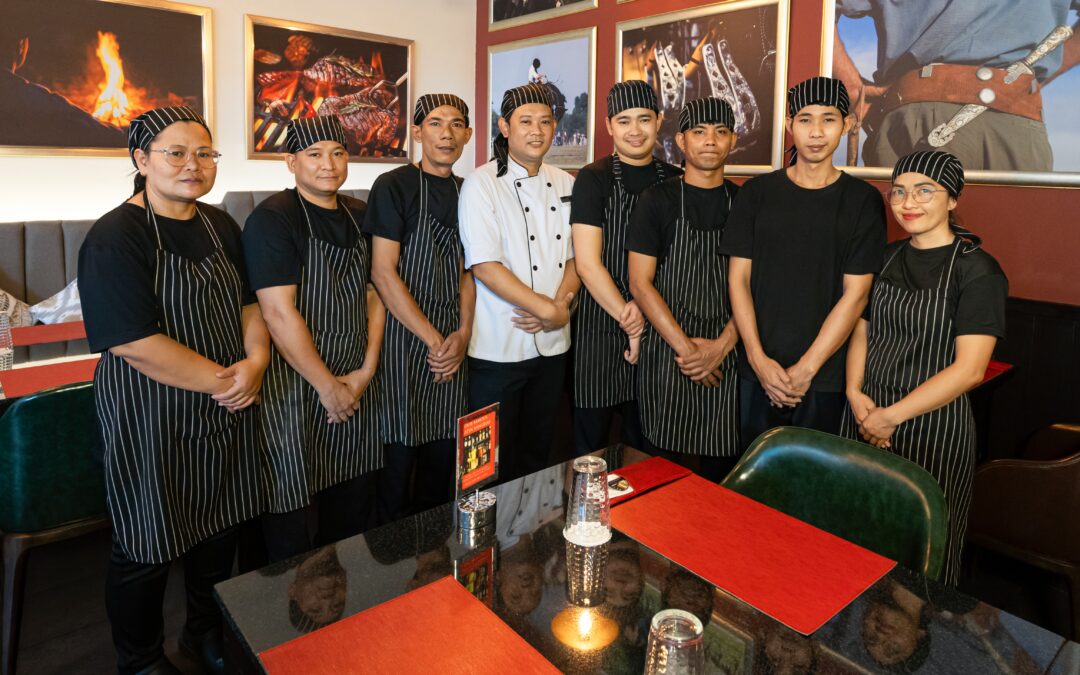
by Ross Kingsley | Apr 20, 2025 | RESTAURANT BUSINESS: BEHIND THE KITCHEN DOOR
The kitchen of a professional restaurant operates like a well-oiled machine, thanks to a system called the brigade de cuisine. This hierarchy, developed by legendary French chef Auguste Escoffier, ensures every role has clear responsibilities, keeping the kitchen efficient and organized. Here’s a look at the various levels of cooks in a professional kitchen:
1. Executive Chef (Chef de Cuisine)
The head of the kitchen, the executive chef is responsible for overseeing all operations. They create menus, manage budgets, hire staff, and ensure quality. In smaller establishments, they might also handle food preparation.
2. Sous Chef
The sous chef is the executive chef’s right hand. They manage the kitchen staff, ensure dishes are prepared on time, and fill in wherever needed. Think of them as the kitchen’s second-in-command.
3. Chef de Partie (Station Chef)
Each chef de partie oversees a specific station in the kitchen. Common station chefs include:
-
Saucier: Prepares sauces and sautéed items.
-
Poissonier: Focuses on fish dishes.
-
Grillardin: Manages grilled foods.
-
Friturier: Handles fried items.
-
Entremetier: Prepares side dishes, soups, and vegetables.
-
Garde Manger: Responsible for cold dishes, salads, and charcuterie.
4. Pastry Chef (Chef de Pâtisserie)
Specializing in desserts and baked goods, the pastry chef often operates as a separate entity from the main kitchen.
5. Commis Chef
The commis chefs are entry-level cooks working under a chef de partie to learn the craft and assist with food preparation.
6. Kitchen Porter
These are the unsung heroes who handle cleaning, washing dishes, and basic prep work.
7. Apprentice (Stagiaire)
Aspiring chefs gain hands-on experience by shadowing seasoned professionals in a learning capacity.
From executive chef to apprentice, every role is essential in creating the seamless symphony that is a professional kitchen.
Image Credit: https://churrascophuket.com
_ _
© Churrasco PHUKET STEAKHOUSE / ALL RIGHTS RESERVED
Churrasco Phuket Steakhouse serves affordable Wagyu and Black Angus steaks and burgers. We are open daily from 12noon to 11pm at Jungceylon Shopping Center in Patong / Phuket.
We are family-friendly and offer free parking and WiFi for guests. See our menus, reserve your table, find our location, and check all reviews here:
https://Churrascophuket.com/
#Churrascophuket #jungceylon #phuketsteakhouse #affordablewagyu #wagyu

by Ross Kingsley | Apr 13, 2025 | RESTAURANT BUSINESS: BEHIND THE KITCHEN DOOR
In the hospitality industry, providing great service often means navigating complex human behavior. While most guests are friendly and reasonable, a small percentage can pose real challenges. Understanding how to manage and de-escalate problematic guest types is key to maintaining professionalism, protecting your team’s morale, and ensuring a smooth operation.
Here’s a look at three of the most frustrating types of guests—and how to handle them calmly and effectively.
1. The Entitled Complainer
Who they are:
This guest believes the rules don’t apply to them. Whether they demand discounts, special treatment, or compensation for minor inconveniences, their default mode is dissatisfaction. They may exaggerate complaints to leverage perks or insist that “the customer is always right,” even when clearly in the wrong.
How to deal with them:
Listen first. Let them speak without interruption to avoid escalating their frustration. Acknowledge their feelings, even if you disagree with their logic. Use neutral phrases like, “I understand why you’d feel that way,” rather than agreeing outright. Then, clearly explain any policies involved and offer a fair solution within the limits of your business. Avoid setting a precedent of rewarding rudeness. If necessary, escalate to a manager—but always stay calm and polite.
2. The Chronic Rule-Bender
Who they are:
These guests ignore house rules, from sneaking in outside food to smoking in non-smoking areas or showing up late and expecting full service. They’re not always aggressive, but they regularly push boundaries and expect leniency.
How to deal with them:
Set clear expectations early. Point out rules calmly but confidently, using signage or prior communication as backup. For example: “Just a reminder, our smoking area is outside by the gate.” Be consistent in enforcing policies; bending rules for one guest undermines your credibility with others. If they repeat the offense, issue a firm but polite warning. If needed, explain the consequences—without threats, just facts. Documentation also helps if the situation escalates.
3. The Loud Disrupter
Who they are:
This type isn’t necessarily angry, but their behavior is disruptive to the atmosphere. They talk loudly on phones, play videos without headphones, or argue publicly with staff or companions. Their behavior often affects other guests, not just your team.
How to deal with them:
Approach discreetly and kindly, ideally away from other guests. Use “we” language to avoid singling them out: “We’ve had a few guests mention the volume—would you mind lowering your voice just a little?” Most aren’t trying to be rude and will cooperate when approached respectfully. If they resist, explain how it’s affecting others. Always prioritize de-escalation over confrontation. Your tone—calm, respectful, and professional—is the best tool in these moments.
Final Thought
Handling difficult guests isn’t about winning an argument; it’s about controlling the tone of the interaction and guiding it toward a resolution. By recognizing common guest behaviors and staying calm under pressure, staff can diffuse tension without sacrificing dignity or service quality. Boundaries, patience, and consistency are your best tools—and often the difference between a bad situation and a manageable one.
Image Credit: https://churrascophuket.com
_ _ _
© CHURRASCO PHUKET STEAKHOUSE / ALL RIGHTS RESERVED
Reprinting, reposting & sharing allowed, in exchange for a backlink and credits
Churrasco Phuket Steakhouse serves affordable Wagyu and Black Angus steaks and burgers. We are open daily from 12noon to 11pm at Jungceylon Shopping Center in Patong / Phuket.
We are family-friendly and offer free parking and Wi-Fi for guests. See our menus, reserve your table, find our location, and check all guest reviews here:
https://ChurrascoPhuket.com/
#Churrascophuket #jungceylon #phuketsteakhouse #affordablewagyu #wagyu




